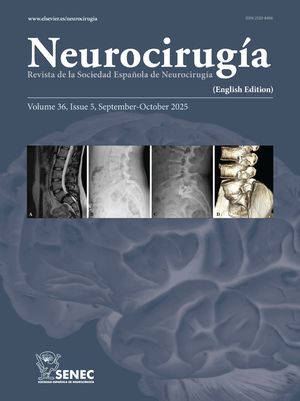Los aneurismas de la arteria oftálmica son lesiones poco frecuentes y con particularidades específicas.
ObjetivoPresentar las características anatomoclínicas, quirúrgicas y los resultados del tratamiento microquirúrgico de nuestros pacientes con aneurismas de esta región.
Pacientes y métodos604 pacientes con aneurismas intracraneales fueron llevados al quirófano entre enero de 1982 y diciembre del 2004. Hubo 50 pacientes con aneurismas de la región de la arteria oftálmica. El promedio de edad fue de 52 años, el 80% fueron mujeres, el 60% presentaban aneurismas múltiples y un 20% gigantes. El 12% poseían lesiones aneurismáticas bilaterales. El 20% de los aneurismas fueron incidentales. El 50% tenían manifestaciones oftalmológicas y la frecuencia se elevó al 100% en los aneurismas grandes y gigantes. El 16% de los trastornos visuales fueron ignorados o confundidos inicialmente. En aneurismas múltiples empleamos la ruta pterional uni o bilateral asociada a otros abordajes. En los aneurismas oftálmicos grandes o gigantes utilizamos la técnica de descompresión-succión retrógrada modificada.
ResultadosTreinta pacientes (60%) obtuvieron una recuperación completa, catorce pacientes (28%) una recuperación incompleta y dos incapacidad grave. No hubo pacientes en estado vegetativo. Hubo cuatro fallecidos (8%). El 50% de los déficit postoperatorios desaparecieron y el 64% de los trastornos visuales mejoraron a los tres meses.
ConclusiónEl método microquirúrgico permitió tratar aneurismas de la región de la arteria oftálmica únicos, múltiples, bilaterales, grandes y gigantes con buena recuperación de los déficit neurológicos y de los trastornos visuales.
Ophthalmic artery aneurysms are infrequent lesions and they have very specific particularities.
Objectiveto present the anatomoclinical and surgical characteristic of our patients with ophthalmic aneurysms and to analyze our surgical results.
Patient and methods604 patients with intracranial aneurysms were operated on between January 1982 and December 2004. There were 50 patients with ophthalmic artery aneurysms. Average age was 52 years, 80% were women, 60% harbored multiple aneurysms and 20% were giant lesions. 12% had bilateral ophthalmic aneurysms. 20% of ophthalmic aneurysms were incidental. 50% had ophthalmological manifestations; howewer, this presentation occurred in 100% of the patients with large and giant aneurysms. Initially, 12% of ophthalmologic disorders were missed. We utilized unilateral or bilateral pterional approach associated to others in multiple aneurysms. We performed retrograde decompression- suction technique modified for large and giant aneurysms.
ResultsThirty patients (60%) obtained a complete recovery, fourteen patients (28%) an incomplete recovery and two were seriously disabled. There were not patients in vegetative state. There were four deaths (8%). 50% of postoperatory deficits disappeared and 64% of ophthalmologic disorders improved three months later.
ConclusionMicrosurgical method allowed to treat unique, multiple, bilateral, large and giant ophthalmic aneurysms with good recovery of neurological and visual deficits.
Article

If it is the first time you have accessed you can obtain your credentials by contacting Elsevier Spain in suscripciones@elsevier.com or by calling our Customer Service at902 88 87 40 if you are calling from Spain or at +34 932 418 800 (from 9 to 18h., GMT + 1) if you are calling outside of Spain.
If you already have your login data, please click here .
If you have forgotten your password you can you can recover it by clicking here and selecting the option ¿I have forgotten my password¿.






